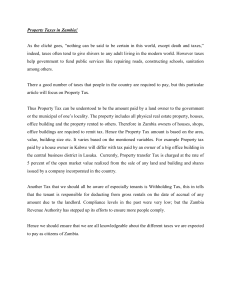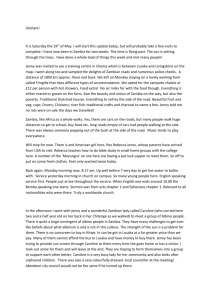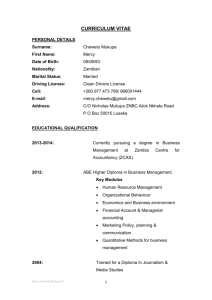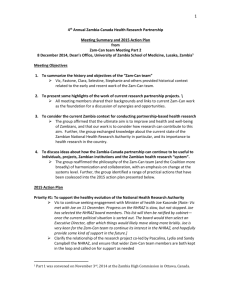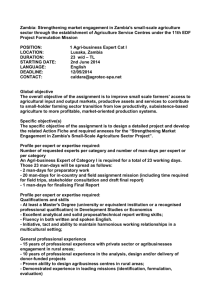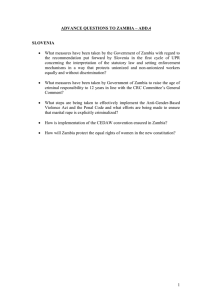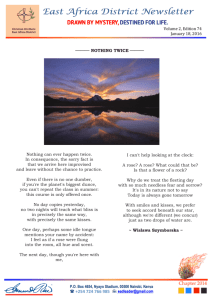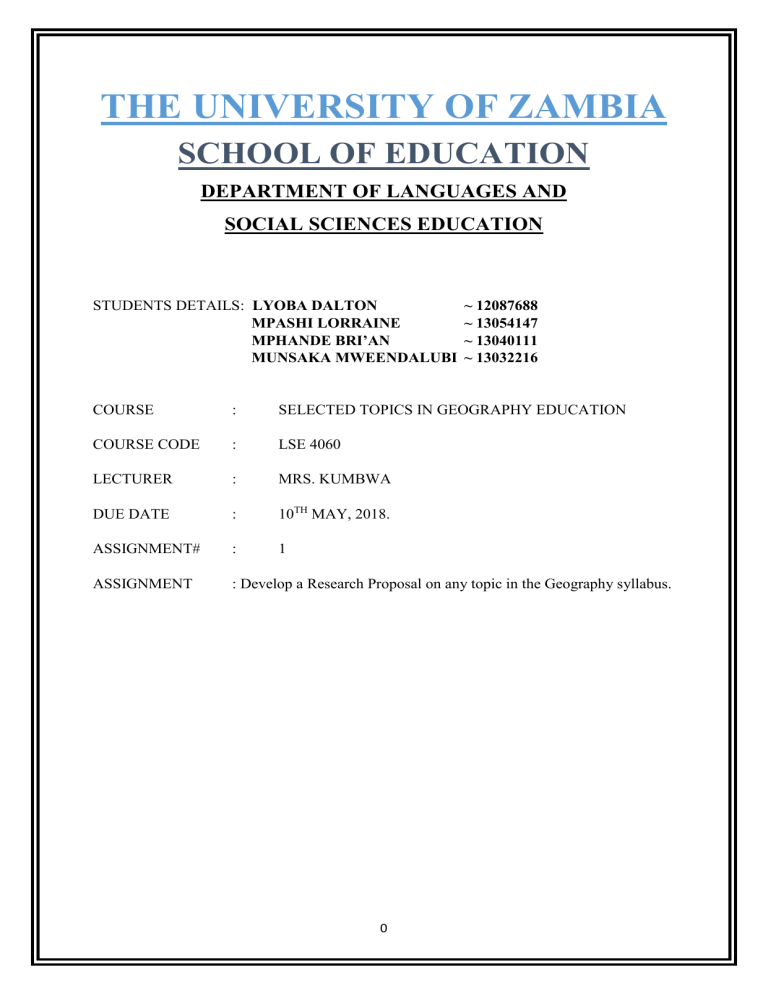
THE UNIVERSITY OF ZAMBIA SCHOOL OF EDUCATION DEPARTMENT OF LANGUAGES AND SOCIAL SCIENCES EDUCATION STUDENTS DETAILS: LYOBA DALTON MPASHI LORRAINE MPHANDE BRI’AN MUNSAKA MWEENDALUBI ~ 12087688 ~ 13054147 ~ 13040111 ~ 13032216 COURSE : SELECTED TOPICS IN GEOGRAPHY EDUCATION COURSE CODE : LSE 4060 LECTURER : MRS. KUMBWA DUE DATE : 10TH MAY, 2018. ASSIGNMENT# : 1 ASSIGNMENT : Develop a Research Proposal on any topic in the Geography syllabus. 0 THE EFFECTIVENESS OF GOVERNMENT WASTE CONTROL MEASURES CASE STUDY OF KALINGALINGA COMPOUND 1.0 INTRODUCTION 1.1 Background of the study Poor waste management has emerged as a global burning environmental problem that most cities are grappling with. According to World Bank (2013) waste generation is likely to exceed 6 million tons a day by 2025 with developing countries being the major contributors to this increase. Zambia being among the developing countries is not an exception as evidenced from the huge volumes of uncollected waste in the capital city, Lusaka and other towns. The Environmental Council of Zambia (2000) revealed that in Lusaka alone, waste generation would grow from 220 000 tonnes in 1996 to 530 000 tonnes by 2011.This has made it almost impossible for the municipal authorities to fulfil their obligations concerning waste management due to limited financial capacity and lack of trained manpower (Robert and Ezeah, 2012). USAID (2001) reports that though private companies stepped in to help collect waste in the city, only an estimated 20,956 tonnes was collected out of a possible 234,329 tons of waste generated in Lusaka city alone by the end of the year 2001. According to Sikazwe (2004), the rapid increase in quantities of waste generated is influenced by industrialization, rapid population growth, urbanization and the increase in un-planned settlements in the city. Households are therefore, the main generators of waste, contributing about 75% of the total amount of waste generated in the city (ECZ, 2010). The effects of the uncollected waste have been manifested through perennial outbreaks of diseases such as cholera, dysentery and pollution of water resources as well as general deterioration of the quality of the environment, especially in the peri-urban areas and adjoining high density areas such as Kalingalinga compound. The Zambian government responded to the problem of waste management by undertaking several initiatives. One of the initiatives was the enactment of the environmental management act of 2011 to provide for the integrated environmental management, protection and conservation of environment as well as sustainable management of natural resources (Environmental Management Act, 2011). Furthermore, Lusaka City Council (LCC) through the waste management unit established partnerships with private companies to collect waste (USAID, 2001). Despite these and many other efforts made by Lusaka city council and cooperating partners to mitigate the problem in many parts of the city, Kalingalinga compound 1 inclusive, there is still poor waste management in the city. This threatens not only the lives of the residents but also the development of the country at large. It is from this background that the need to determine the effectiveness of the control measures put in place to manage waste by government has been derived. 1.2 Problem statement In Zambia’s capital city, Lusaka, and Kalingalinga in particular, waste management has been of great concern. Past research has been carried out focusing on the role played by local authorities on waste management. For instance, research carried out in Kalingalinga by Dauchi (2002) and Sibanda (2010) indicated that government has put in place control measures such as communal bins and door to door garbage collection vehicles which have been put in place to collect waste. Despite these efforts by local authorities there are still huge volumes of uncollected waste in the area which has led to the outbreak of diseases like cholera and dysentery. It has also led to the blocking of drainages and pollution of land and air. These studies, however, did not take into account the effectiveness of the waste control measures put in place by local authorities in Lusaka, particularly Kalingalinga compound. Therefore, this brings about the need to carry out a research on the how effective of the waste control measures have been. 1.3 Aim To investigate the effectiveness of waste control measures established by the local authorities for Kalingalinga compound. Specific objectives To assess the existing waste control measures are in Kalingalinga compound. To identify challenges faced by the residents in waste management. To identify challenges faced by the local authorities in waste management. To identify positives aspects of the waste management in Kalingalinga compound. 1.4 Research questions What the existing waste control measures Kalingalinga compound? What are the challenges faced in the collection of waste? What are the positive aspects of the waste management in Kalingalinga compound? 2 1.5 Significance of the study The findings of this study might help institutions responsible for managing waste in finding appropriate solutions to tackle the problem of poor waste management in Kalingalinga compound. The results will also add new literature to the existing body of knowledge. The findings will also contribute to policy framework by helping policy makers to re-strategize approaches aimed at improving waste management in the compound and the city at large. 1.6 Ethical considerations This research is likely to disrupt peoples’ normal activities, as a result people might not be willing to participate in the study. Therefore this research will ensure that participants are not coerced (no participant will be forced to participate in the research). In the case were participants agree to participate, the study will ensure that the respondent’s names will not be written on the interview schedule and the information collected will be treated with at most confidentiality. Further, participants will be informed that the data collected will be for academic purposes only and permission from the participants will be obtained for information to be shared publicly. Lastly this study will strive to take into consideration all those ethical issues that will arise in order to conform to best research standards. 2.0 LITERATURE REVIEW 3 Waste is garbage, refuse, sludge and other discarded substances from anthropogenic activities such as industrial, commercial, domestic, social gatherings and community activities (ECZ, 2008). On the other hand, Waste Management (WM) entails a systematic process of handling waste including generation, storage, sorting and treatment as well as transportation for disposal to avoid adverse effect on the environment (ZEMA, 2011). Waste Management at Global Level Poor waste management is one of the great challenges of modern society which has become a global burning environmental issue today. It is influenced by rapid population growth, urbanization and the growth of spontaneous settlements, socio-economic development as well as the consumerism syndrome of the complex society (Sikazwe, 2004). According to a study done in Indonesia by Panneerselvam and Ramakrishnan (2005), every day, each person produced waste in the range of five hundred grams to four kilograms, especially in today’s popular culture of using disposable materials like plastic bottles, plates, folks, spoons, diapers and food wrappers. This accumulation of garbage is alarming as it translates to about 400 million tons of garbage thrown away all over the world per day which if not handled properly can impact the environment negatively. In other words, poor waste management has a detrimental effect not only to the environment but also to the inhabitants of the earth. Its effects range from environmental degradation, perennial outbreak of diseases such as cholera, dysentery and pollution of water sources (Ibid). As a response to poor waste management, the first United Nations conference on Human and the Environment was held in Stockholm in 1972. The conference attempted to resolve environmental issues and gave birth to United Nations Environmental Program (UNEP) which took up the challenge of championing environmental issues through campaigns, education, public awareness and conferences (UNCEP, 1992). Twenty years later another conference was held in Rio de Janeiro in Brazil in June 1992. The conference gave birth to the concept of a ‘green agenda’ which was all about linking environment and development. Issues of decision making and accountability to man’s activities towards the environment were seen as a priority (Ibid). However, despite these efforts by the United Nations, many countries world over continued to record poor waste management as evidenced from the continued environmental degradation especially in developing countries (Chibinda, 2016). Waste Management in Developing Countries 4 In most developing countries, poor waste management has continued to be a challenge as these countries are still grappling with the collection component of waste management (Chibinda, 2016). This is so because waste management is still a municipality’s responsibility nearly in all developing countries. Ezeah and Robert (2012) stressed that municipalities in developing countries have a huge problem of managing waste due to financial and administrative capacity constraints. These constraints have resulted in municipalities collecting only less than 50% of the total waste generated in these countries (Ibid). The rest of the waste is dumped everywhere in townships, urban centres, along the roadsides and other undesignated places (Op.Cit). For instance, Studies done in Jakarta (Indonesia) by Miller and Spoolman in 2012 revealed that an average of 1400 cubic meters of garbage is thrown into the Jakarta River every day. The study also revealed that the problem is not simply a matter of garbage collection but also due to lack of environmental awareness to the residents. Realizing the importance of environmental awareness, Jakarta started carrying out some environmental awareness programs among residents (Miller and Spoolman, 2012). Another study conducted in Narawe, Pakistan, revealed that there was no proper waste management system put in place in the area. This study observed that practices and knowledge play an important role in determining their waste disposal culture. It further indicated that the state/ local government have not done well in educating the people in sanitary hazards of indiscriminate waste dumping and management (Shekwo, 2012). This study was very informative although it did not bring to light the effectiveness of the waste control measures put in place by local authorities. Thus, Ezeah and Robert (2012) stated that the fact that waste in developing countries is taken care of by the municipalities explains why some individuals see poor waste management as not a problem when it actually is. Waste Management in Zambia Zambia being a developing country, it is not spared from poor waste management. The increasing amount of uncollected waste particularly, in Zambia’s capital city, Lusaka, is disturbing. A study carried out in Lusaka revealed that over a million tons of municipal waste, particularly solid waste, was generated each year (Matenga and Muyakwa, 1999). The study also revealed that management of various types of wastes has been a challenging issue in Zambia as manifested from the perennial outbreak of diseases such as cholera and dysentery as well as loss of aesthetic beauty. In responding to the situation, the Government of the Republic of Zambia (GRZ) enacted a legislation of the environmental management act of 2011 to provide for the integrated environmental management, protection and conservation of 5 environment as well as sustainable management of natural resources (ZEMA, 2011). This gave birth to the Zambia Environmental Management Agency (ZEMA) whose mandate among other things is to ensure the integration of the environmental concerns in overall national planning through coordination with appropriate authorities (Ibid). However, despite the legislations in place and many other efforts made by the government, Lusaka City Council and other cooperating partners to mitigate poor waste management in many parts of the city, Kalingalinga compound inclusive, there is still poor waste management in the city. According to Chibinda (2016) only less than ten percent of the generated waste in Lusaka is reclaimed or collected while the remainder ends up in the undesignated dump sites, drainages, roadsides and community grounds. Thus, the current waste management situation in Lusaka and in particular Kalingalinga compound leaves much to be desired. Knowledge, Policies and Practices As seen from the above studies, the significance of policies, knowledge and practices in assessing waste management provides a diagnostic tool in determining the problem and identifying solutions. According to Kaliyaperumal (2007), the knowledge possessed by a community refers to their understanding of any given topic, in this case waste management. While practices refers to ways in which they demonstrate their knowledge through actions. Therefore, Knowledge on waste management is a critical and necessary element in the management of waste. Lack of knowledge brings about poor waste management practices. This is evident in a study conducted by Jurczak (1997) who observed that there is a general generation of waste, and its disposal in undesignated places had significantly increased in Poland due to lack of knowledge on waste management by the residents. He further indicated that in order to increase residents’ knowledge towards waste management, professional workers as well as environmental institutions should deliver awareness programs to the residents. The aspect of knowledge is very vital to waste management because it informs policy. Local authorities can only implement policies that people in the general community have a proper understanding of. Poor policies, otherwise, could lead to inappropriate practices, as in the case of most less-developed countries, in which poor practices in major urban communities constitute one of the major factors leading to declining environmental health conditions (Peters, 1998). An example of such inappropriate practice is burning. Burning method of waste disposal is a health hazard in that it pollutes the air. According to a study conducted by Lvovsky (2000), 6 projections indicated that about 3.5million people would die prematurely over the next 20 years as a result of indoor and outdoor air pollution. With regards to policy, there is a wide legislation on environmental issues in Zambia. National environmental policies formulated by relevant bodies consider theoretically the effective management of waste as part of the environmental protection strategy and pollution control and especially the protection of public health. National environmental policies consider, in principle, an effective management of waste as part of the environmental protection strategy and pollution control and especially the protection of public health (Anand, 2010). Waste management is regulated by the Parliament Act, 2004, which instituted the Waste Management Unit at Lusaka City Council. In addition, there is the Environmental Management Act (GRZ, 2011) e l’Health Act which treats these issue. This is a high-quality and updated legislation. It defines a separate waste management, in order to recycle materials according to the different product categories, and landfill disposal of mixed waste. Moreover, it considers sanctions for irregular practices of waste disposal. Although there is a number of literature on waste management and its associated problems on Zambia and many other countries, most of this literature has not brought to light the effectiveness of the control measures on waste management by the relevant authority. Therefore, this study ought to be undertaken as it focuses on the effectiveness of the control measures on waste management by the authorities. 3.0 METHODOLOGY 7 Research Design The proposed research design for the study is the non-intervention particularly descriptive and explanatory type. This is because it will be based on non-experimental designs as it will be conducted in the natural and uncontrolled setting which is Kalingalinga compound. In addition, it is a case study which is purely qualitative as it only focuses on one area and seeks to collect detailed information on the effectiveness of government measures put in place to reduce the amount of uncollected waste and role of Kalingalinga residents in waste management. Research Site The study will be done in Kalingalinga compound and Lusaka city council offices. These areas were particularly selected because Kalingalinga has been observed to be one of the most littered compounds in Lusaka city and city council authorities have information concerning the current problem that will help determine how effective the waste management plan implementation has been Target group and sampling methods The study will have a sample size of 30 comprising of two target groups, A and B. Target Group A This will consist of the residents of Kalingalinga compound who will be the main target group comprising 25 households. This target group is important to this study because it is observed that households are the main generators of waste (Chibinda, 2016). The sampling method to be used on this target group will be systematic sampling. In order to achieve this, households will be selected with an interval of five (5) houses. Target Group B: This will have a sample of not more than 5 key informants from government and private organizations. These key informants will be included in the study because they are in charge or play a major role in waste management. Purposive sampling will be used to select this target group because they possess some characteristics considered relevant to the study. Data collection This research will use both secondary and primary data. Secondary Data In as much as primary data will be the main component in this study, secondary data will also be used. This will assist in drawing up comprehensive background information on the topic. The sources of secondary data will include the use of reports, research articles, conference papers and books which will be obtained from the University of Zambia main library, Lusaka 8 City Council and the Zambia Environmental Management Agency through their library. This data will provide background information of the study as well as add to the content of the literature review. However, it should be mentioned that secondary data will not be the main source of data in this study. The main source of data will be primary data. Primary data Primary data is important to this study because it will provide empirical evidence on the topic under investigation. This information will be collected directly from Kalingalinga residents, Lusaka City Council and ZEMA. Data collection tools Data from participants will be collected using an interview schedule. In-depth interviews will be held with the key informants such as the LCC staff and ZEMA officers. An interview guide will be prepared to guide the interview. Participants will be asked these questions on a one to one basis whilst the researcher will be taking down notes. Interviews are the best tool to use because they will create a platform for getting insight information on the problem at hand and the respondents will have a chance to ask for clarification where they are not clear. Data Analysis Data analysis will be done when primary data has been collected. Exploratory data from the interviews will also be checked for clarity. The data collected will then be analysed manually by grouping similar responses together using themes. Those which are not similar will also be grouped in different categories. Finally, the responses will be written in narrative form using themes and direct quotations. REFERENCES 9 Anand, S., (2010), Solid Waste Management in the World's cities, Online at: file:///C:/Users/user/Downloads/2918_alt.pdf. Chibinda, D. (2016). Municipal Solid Waste in a Circular Economy Perspective: A Case Study of Lusaka City in Zambia. Swedish University of Agricultural Science: Uppsala. Dauchi, A. (2002). Solid Waste Management Strategies in High Density Informal Residential Areas: Case Study of Kalingalinga. UNZA Press: Lusaka. ECZ, (2004). National Solid Waste Management Strategy for Zambia. ECZ: Lusaka Environmental council of Zambia (ECZ). (2008). Zambia Environment Outlook Report 3. ECZ: Lusaka. Ezeah C. and Roberts C. L. (2012). Analysis of Barrier and Success Factors Affecting the Adoption of Sustainable Management of Municipal Solid Waste in Nigeria. In Environmental Management Journal, vol. 103, pp. 9-14 GRZ, (2011), Government of the Republic of Zambia, Environmental Management, Online at: http://www.zema.org.zm/index.php/environmental-legislation. Heeranum K.K. (1993). Solid Waste Management in Mauritius: An Alternative to Sanitary Landfill. MOEQL: Mauritius. Jurczak M. G. (1997). Ecological awareness of nature teachers in Poland. Jagiellonian University: Krakow. Kaliyaperumal K. (2007). Community Ophalmology; guidelines for conducting a knowledge practice study. Aravid eye hospital and postgraduate institute ophthalmology: Gandhi Nagar. Lvovsky. (2000). Health and environment; Environmental strategy background paper. The World Bank. Washington DC. Matenga C.R and Muyakwa S.L. (1999). Livelihood from solid waste management in Lusaka: Challenges and opportunities. Ministry of environment and natural resources: Lusaka. Miller G.M and Spoolman. (2012). Environmental science. Jack Carey: Canada. Mwiinga F.B. (2010). Solid waste management in Zambia. The case of Choma. UNZA: Lusaka. 10 Panneerselvam A. and Ramakrishnan R. (2005). Environmental Science Education. Sterling Publishers Pvt. Ltd: New Delhi. Peters K. (1998). Community bases waste management for environmental management and income generation in low income areas. Canada’s office of urban agriculture: Nairobi. Shekwo J. (2012). Managing Solid Waste in Nigeria: Social and Health Implications. Nasarawa State University: Nasarawa. Sichaaza H. (2009). An assessment of knowledge, attitudes and practices towards waste management among Ng’ombe residents. UNZA press: Lusaka. Sikazwe T. (2004). A study of solid waste management in Kaunda Square. UNZA press: Lusaka. UNCEP, (1992). Chapter 36: promoting education, public awareness and training of agenda 21. Report of the United Nations conference on development, Rio de Janeiro, Brazil. Available at http://www.unesco.org/iau. Accessed 30th march 2017. USAID (2001) Waste Management Study: Towards Sustainable Solution. USAID: Lusaka. World Bank (2013). Global Environmental Issues. World Bank: Washington DC. Zambia Environmental Management Agency ((2011). Waste Management. ZEMA: Lusaka. WORK PLAN 11 ACTIVITY April Proposing research topics and Submission of topics Problem statement write up and submission. Drafting of chapter one and submission April May May May June June Drafting of chapter two, tree and appendices as well as submission Compilation and submission of final research proposal Question pre-testing and Data collection Data analysis and interpretation Report writing and submission BUDGET Description Stationary Ream of paper Pens Books Secretarial Services Proposal printing Report printing Photocopying instruments Transport Meals Quantity Unit Price (ZMW) Amount (ZMK) 50 3 15 50 15 15 15 1 5 1 1 1 30 61 300 15 30 300 5 5 30 60 150 300 TOTALS: 875 THE UNIVERSITY OF ZAMBIA 12 July SCHOOL OF EDUCATION DEPARTMENT OF LANGUAGE AND SOCIAL SCIENCE EDUCATION LSE 4060 INTERVIEW SCHEDULE RESEARCH TOPIC: THE EFFECTIVENESS OF GOVERNMENT WASTE CONTROL MEASURES - CASE STUDY OF KALINGALINGA COMPOUND. Dear, Respondent: We are students from the University Of Zambia carrying out a research on the above topic. With reference to the above topic, you have been selected as part of the sample to help in this research. You are requested to answer the questions as honestly as possible. Kindly note that the research is purely for academic purposes. Therefore, you are being assured that the information obtained will be treated with utmost confidentiality. Your cooperation will be highly appreciated. SECTION A: KNOWLEDGE AND PRACTICES 1. What do you understand by the phrase Waste Management? 13 ………………………………………………………………………………………… …..……………………………………………………………………………………… …..……………………………………………………………………………………… 2. How do you manage your waste? ………………………………………………………………………………………….. ………………………………………………………………………………………….. 3. What method(s) do you use to dispose off your waste? ………………………………………………………………………………………….. …………………………………………………………………………………………… 4. Give reasons for using the method you have mentioned in question 3. …..……………………………………………………………………………………… .….……………………………………………………………………………………… 5. In your opinion, what causes poor waste management? ……………………………………………………………………………………………. ……………………………………………………………………………………………. ……………………………………………………………………………………………. 6 Are there any sensitization programs carried out in your area? ……………………………………………………………………………………………..… 7. If the answer to the previous question is yes, which institution(s) conduct the program? ……………………………………………………………………………………………….. SECTION B: CHALLENGES ON WASTE MANAGEMENT 8. Is there a company that collects waste in your area? 14 a) Yes b) No 9. If your answer to the previous question is yes, what services do they provide? …………………………………………………………………………………………… 10. what benefits have you gained for the services provided?...................................................................................................................................... .... 11. If your answer to question 8 is yes, do you pay any fees for the service? a) Yes b) No 12. If your answer to question 10 is yes, are the fees affordable? a) Yes b) No 13. What other challenges do you face with regards to waste management? ………………………………………………………………………………………………… ………………………………………………………………………………………………… ………………………………………………………………………………………………… SECTION C: RECOMMENDATIONS 14. In your opinion, what are some of the solutions that can help improve waste management in your area? ……………………………………………………………………………………………… …………………………………………………………………………………….……… 15 INTERVIEW GUIDE FOR THE LOCAL AUTHORITIES 1. What awareness programs have been conducted on waste management in Kalingalinga? 2. What role do residents in Kalingalinga play in waste management? 3. How effective have the waste management measures been in Kalingalinga compound? 4. Is there any charge for the services provided to the residents? 5. If the answer to the previous question is yes, what happens to the waste of residents who cannot afford to pay the charge? 6. What challenges do you face concerning Waste Management in Kalingalinga? 7. What measures have you put in place to improve waste management? 16
